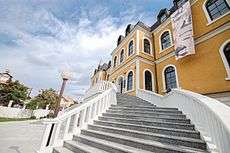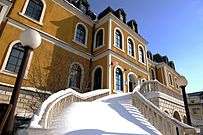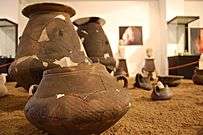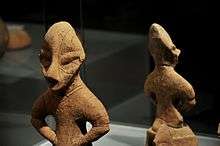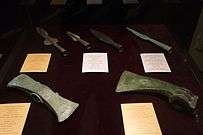Kosovo Museum
Kosovo Museum (Albanian: Muzeu i Kosovës, Serbian: Музеј Косова / Muzej Kosova) is the National Museum of Kosovo[a], located in the city of Pristina.[1][2][3] It was founded in 1949 and is the largest museum in Kosovo. However, the building of the museum was constructed in 1889 and it was designed according to the Austro-Hungarian style of construction and its real aim was establishing the high military command of that time.
Muzeu i Kosovës Музеј Косова / Muzej Kosova | |

| |
| Established | 1949 |
|---|---|
| Location | Ibrahim Lutfiu, Pristina, Kosovo |
| Type | National Museum |
The Museum is the earliest institution of cultural heritage in Kosovo, established with the goal of preserving, restoration-conservation and presentation of movable heritage on the territory. It is situated in a special facility, from an architectural point of view but also because of its location since it is situated at the old nucleus of the city centre.
History
Founded in 1949, the Kosovo Museum has departments of archaeology, ethnography, and natural science, to which a department for the study of history and the National Liberation Struggle was added in 1959. It has been active in sponsoring archaeological excavations, conservation and other scientific work. Since 1956 it has published an annual journal called Buletin i Muzeut të Kosovës, with articles in Albanian (with summaries in French, English, or German).[4]
The overall museum consists of three museum parts: Kosovo Museum itself, Emin Gjiku’s Housing Complex where an ethnological exhibition has been presented, and the Museum of Independence. Museum consists of four sectors, archaeological sector, ethnological sector, historic sector and natural sector. The main museum building consists of 3 halls or galleries and one of them serves as a hall for permanent archaeological exhibitions, but various exhibits are also presented in the inner yard of the museum as well at the lapidarium, respectively in the Archaeological Park, which is located next to the museum building, or on the right side of it. In the cellars of the museum, are located the warehouses of thousands of findings, artefacts and movable fragments of archaeological material, which are systematized and kept in special conditions with particular attention and care. Within the building of Kosovo Museum, namely on its third floor, you can find the working environment of Kosovo Archaeological Institute, a scientific-professional institution and responsible for archaeological research.[5]
The Ethnological Museum
The Ethnological Museum is an integral part of the Museum, located in the old housing complex, consisting of four buildings: two of which date from the 18th century and two others from the 19th century.
The housing complex was constructed by Gjinolli family or Emin Gjiku who then migrated to Turkey in the years 1958–59. Later on, the Natural Museum was opened in this housing complex. In 2006, a permanent ethnological exhibition of Kosovo museum was set in this housing complex. The concept of ethnological museum is based on 4 topics which present the life cycle starting from birth, life, death and spiritual heritage of the Serbs.
The stone house or the synagogue is also a part of the museum which during the 1950s was transferred from the old part of the city of Pristina to this housing complex. Today it serves as a centre of contemporary art – Station.[6]
The Archaeological Park
The Archaeological Park, the Lapidarium of Kosovo Museum, was designed to become an additional part of an outdoor exhibition of archaeological heritage of Kosovo. Architectural fragments, epigraphic inscriptions, altars and kennels or grave stones, that apart from mythological scenes, funeral processions, presentation of images of the past descendants supplemented with carved inscriptions, all of these reflecting upon the spiritual and material world of Dardania’s ancient period.
The Archaeological Park of Kosovo Museum has been designed to serve as a lapidarium, which is a predetermined place for exhibiting stone monuments and architectural fragments of an archaeological nature. The Park is intended to serve as a memorial place for the antiquity and the level of civilisations from ancient times and also for the organisation of cultural and educational events for children and young people.
Gallery
See also
- Tourism in Kosovo
- History of Kosovo
- Albanians
- Pristina
Notes
| a. | ^ Kosovo is the subject of a territorial dispute between the Republic of Kosovo and the Republic of Serbia. The Republic of Kosovo unilaterally declared independence on 17 February 2008, but Serbia continues to claim it as part of its own sovereign territory. The two governments began to normalise relations in 2013, as part of the 2013 Brussels Agreement. Kosovo is currently recognized as an independent state by 97 out of the 193 United Nations member states. In total, 112 UN member states recognized Kosovo at some point, of which 15 later withdrew their recognition. |
References
- "National Museum, Prishtinë (Priština), Kosovo". National Geographic. Western Balkins Geotourism MapGuide: Land of Discovery. Retrieved 7 May 2014.
- "Kosovo Museum". TripAdvisor. Retrieved 7 May 2014.
- "Kosovo Museum". Google+. Google. Retrieved 7 May 2014.
- Riedlmayer, András (March–June 2000). Museums in Kosovo: a first postwar assessment. Bosnia Report. UK: Bosnian Institute. Archived from the original on 18 October 2012. Retrieved 23 February 2013.
- "Kosovo Museum – About". Archived from the original on 2013-04-12. Retrieved 2013-02-22.
- "The Ethnological Museum". Archived from the original on 2013-04-12. Retrieved 2013-02-22.
